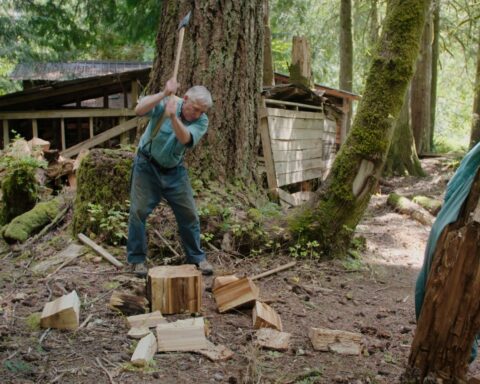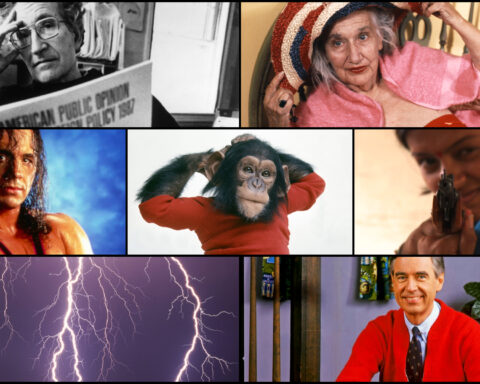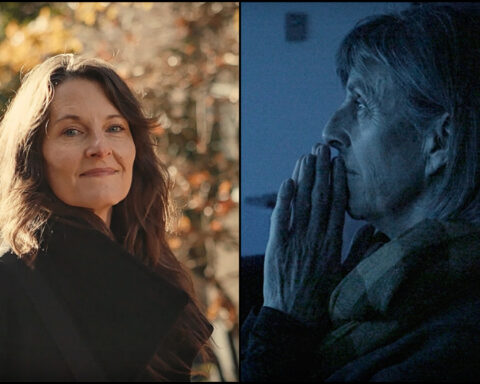When Nettie Wid’s KONELĪNE: our land beautiful (2016) collected three Canadian Screen Award nominations this year, it was another highlight in British Columbia’s rich documentary legacy. It’s a history of innovation, resilience and social conscience that includes some of Canada’s best filmmakers—and it began even before films were called documentaries. [Watch KONELĪNE: our land beautiful for free at Knowledge Network.]
Edward Curtis’s 1914 production In the Land of the Head Hunters was B.C.’s first documentary and first narrative feature. Beautifully shot, the film moves between documenting and fictionalizing the Queen Charlotte Islands’ Kwakwaka’wakw First Nations. While it was critically praised, Curtis’ Head Hunters wasn’t a commercial success and the American-born photographer never made another doc. At around the same time, a Canadian filmmaker, Manitoba’s Arthur David “Cowboy” Kean, resettled in B.C. and began to make movies. For a decade Kean made government-funded documentaries, including Whaling: British Columbia’s Least Known and Most Romantic Industry, shot in 1916–17 on the west coast of Vancouver Island.
In the early 1940s, propaganda and promotional films comprised the bulk of B.C.’s documentary output. From the 1940s to the mid-1960s, some 150 National Film Board (NFB) productions included B.C. scenes. Eastern crews added western moments to wartime
propaganda films in the NFB’s Canada Carries On series such as Warclouds in the Pacific (1941) and Trans-Canada Express (1944). In the postwar years, NFB filmmakers visited B.C. to shoot films like Klee Wyck (1946), about artist Emily Carr, and The Home Town Paper (1948), about the editor of the Vernon News. Meanwhile, Leon Shelly’s Motion Skreenadz made industrial product, including Beautiful British Columbia (1941), which used a California crew. After Shelley relocated to Toronto, Lew Parry picked up the industrial torch, making more than 200 promotional films.
Non-commercial, substantive documentary filmmaking took longer to take hold in B.C. The earliest attempts were no-budget amateur productions by members of the Vancouver Film Society (VFS). In the 1930s, the VFS screened foreign films (including documentaries) and Hollywood classics. In 1939, VFS member Oscar Burritt directed Stanley Park about a day in the life of Vancouver’s famous park. After World War II, two Kitsilano High School film fanatics, Allan King and Stan Fox, joined the film society. Older VFS members encouraged Fox and King’s filmmaking aspirations. Fox’s 1947 film, Suite Two, documented the daily routine of film society member and bohemian-about-town Dorothy Burritt. Fox’s follow-up, In the Daytime (1949), was inspired by the classic European “city symphonies” Berlin: Symphony of a City (Walter Ruttmann, 1927) and Rien que les heures (Alberto Cavalcanti, 1926), about Paris. With a $60 budget provided by the VFS, Fox wandered the city with his 16mm camera aimed at Chinatown, Stanley Park’s Lost Lagoon, and under bridges. “The film is mostly about non-bourgeois people because they appealed to us. They were more interesting and colourful,” says Fox. He screened In the Daytime for the VFS and sent a copy to the brand new Canadian Film Awards (later renamed the Genies) in Toronto. It won an honourable mention in the “amateur” category, finishing second to Claude Jutra’s Mouvement perpétuel (1949).
In 1953, editor Arla Saare returned to Vancouver from Ontario to help set up the film unit at the CBC’s new CBUT station. A “totally brilliant” editor according to Fox, Saare was at least as essential as any director in establishing B.C. documentary film. Born in Finland in 1915, Saare moved to Canada with her family in 1924 and never forgot the poverty she came from, leading her to infuse into the unit’s work the deep empathy and social conscience that became the trademarks of B.C. documentary. “Arla was a very ethical person,” says Fox, who was Saare’s first assistant at CBUT. “And she was very, very influential with everybody. That’s where Allan King learned and other people like George Robertson and Daryl Duke. Arla would actually show these guys how to make films and then she would be very critical of what they were doing and very helpful in a powerful way. So that’s where it all started.”
CBUT gave B.C. documentary filmmakers their first real opportunities, and they took full advantage. Alongside Stan Fox and Arla Saare, the CBUT film unit included talented producer-directors such as Allan King, Daryl Duke, Gene Lawrence, William Brayne, Ron Kelly and Michael Rothery. The unit’s breakout film was King’s Skid Row (1956). King’s personal manner was “very soft and quiet but inside he had really strong, strong feelings about things,” Fox says of his lifelong best friend. For the film, King profiled three homeless men addicted to alcohol in Vancouver’s skid row. Shot by cameraman extraordinaire Jack Long, the footage was edited by Saare. “I can remember to this day Arla talking to Allan about Skid Row and the people he was photographing, and telling him how to deal with them,” Fox says. ”But basically it was Allan’s film. It’s a Canadian classic.”
King would make several notable documentaries at CBUT, including The Pemberton Valley (1957), before moving to Toronto, where he achieved iconic status with his 1960s masterpieces Warrendale (1967) and A Married Couple (1969). Another memorable unit film, Cariboo Rodeo (1960), directed by William Brayne and edited by Saare, brought First Nations’ peoples and cowboys together in rodeo action. Other unit highlights include Gene Lawrence’s Michel (1959), Jim Carney’s City Song (1961) and George Robertson’s Victoria 100 (1962). Fox himself made What Happened Last Summer? (1967) about the counterculture in Vancouver’s Kitsilano neighbourhood. “Television allowed you to finance these things,” remembers Fox. But by the early 1970s, the unit’s filmmakers had lost much of their autonomy. “They turned down a lot of programmes I suggested.”
Nails, Phillip Borsos, provided by the National Film Board of Canada
In 1965, the NFB opened a regional office in Vancouver and went on to produce Robert Fresco and Kris Peterson’s Mudflats Living (1971), Tom Shandel’s We Call Them Killers (1972), Daryl Duke’s David and Bert (1975) and Sandy Wilson’s Pen-Hi Grad (1975). Phillip Borsos arrived in the 1970s with three acclaimed documentary shorts, Cooperage (1976), Spartree (1977) and the Genie-winning, Oscar-nominated Nails (1979), which managed to make the history of nail production dramatic and beautiful. A decade later, Genie nominations for best documentary went to Vancouver’s Kirk Tougas (Return to Departure, 1987) and Colin Browne (White Lake, 1990).
Nettie Wild started out as an actress and her sense of drama and character permeates her documentaries. After graduating from the University of British Columbia (UBC), Wild traveled to the Philippines to perform, only to find herself doing theatre for a barefoot guerrilla army in the mountains. That led to her first feature A Rustling of Leaves: Inside the Philippine Revolution (1988). With funding from Britain’s Channel 4, she returned to the mountains to film the guerrillas and the vigilantes fighting them. “We ended up making a film which was very, very difficult on all fronts,” she remembers. “I just about went out of my mind.” It was nominated for a Genie and won the People’s Choice award at the Berlin International Film Festival.
She’s continued to redefine notions of “brave filmmaking,” often stepping into the heart of conflict, with Blockade (1993), A Place Called Chiapas (1998), Fix: The Story of an Addicted City (2002), and KONELĪNE: our land beautiful. A Place Called Chiapas was the first B.C. film to win a Genie for best documentary feature. In 2003, Fix began a three-year best-documentary winning streak at the Genies for B.C. filmmakers. Jennifer Abbott and Mark Achbar’s The Corporation (2003) and Velcrow Ripper’s Scared Sacred (2004) successfully followed her film.
Wild’s films have spurred debates on issues, but she’s taking a different tack with her latest, KONELĪNE, a luminous look at the character of northwestern B.C. “The reason why the form of KONELĪNE is so different than all my other ones is that I really felt that there’s this huge roar of rhetoric and not a whole lot of listening. I think that’s dangerous,” she says. “Our objective is trying to find poetry in every single person in front of our camera, including the diamond drillers and the people putting in the transmission lines as well as the Tahltan First Nation elders protesting against them.”
The film is filled with stunning visuals, including a slow-motion look at a 16,000-pound transmission tower being lowered by the world’s largest helicopter. “By shooting in the abstract—hyper telephoto, hyper slow motion—we’re revealing a kind of poetry,” she says. “We’re seeing an elegance of engineering; we’re seeing a weird kind of beauty; we’re seeing this phenomenally gorgeous landscape; we’re seeing these big guys rendered puny by this huge endeavor that looks impossible; and we’re seeing the devastation of the clear cut. It’s all in the frame and nobody has to say a word.”
The film has been celebrated—it won Best Canadian Documentary at the 2016 Hot Docs festival in Toronto— but distribution woes have Wild wondering about the future of documentary. “Access to our theatres has always been difficult,” she says, but things have gotten even harder. “Now I’m lucky to get in at five o’clock or one day in the middle of the week.” She notes the irony of the “Stan Fox thing that TV had been the incubator here…I’ve also had to withstand the onslaught of reality TV and how that has completely undermined the art form of documentary and the budget.” To achieve the quality she wants, Wild puts four years into a project. “It’s the opposite of quick and dirty.”
There are now numerous talented documentary filmmakers in B.C. and many are feted at festivals around the world. Sonia Suvagau, for one, has been particularly prolific since graduating from Simon Fraser University (SFU) in 2010. Her grad short Salvation (2010) won best student film at the L.A. Global Film Festival, and she’s directed TV and the acclaimed documentaries Rose Colored Glasses (2011) and Our 1/4 Life Crisis (2014). Some innovative B.C. filmmakers move between documentary and other film forms, sometimes in the same movie. Ann Marie Fleming, for instance, combined documentary and animation to create her own distinctive magic realism in The Magical Life of Long Tack Sam (2003). Julia Kwan made a smooth transition from award-winning narrative filmmaking (for Eve and the Fire Horse (2005)) to award-winning documentary with Everything Will Be (2014).
B.C. filmmakers cobble together funding for passion projects like Gwen Haworth’s autobiographical transgender story She’s A Boy I Knew (2007) or Susanne Tabata’s punk rock history Bloodied But Unbowed (2011). There are also heralded NFB-supported productions such as Limit is the Sky (Julia Ivanova, 2016), Ninth Floor (Mina Shum, 2015), Shameless (Bonnie Sherr Klein, 2006), From Harling Point (Ling Chiu, 2003), Eco-Pirate: The Story of Paul Watson (Trish Dolman, 2011) and Debris (John Bolton, 2015). B.C. filmmakers won back-to-back best-film awards at Toronto’s Hot Docs festival for Charles Wilkinson’s Haida Gwaii: On the Edge of the World (2015) and Wild’s KONELĪNE.
As for Stan Fox, he still has the love for film he had back in 1947, and often talks with young B.C. filmmakers. “They have to spend so much time raising money, making contacts, doing things that have really nothing to do with making film,” he says. Despite those obstacles, Nettie Wild remains optimistic: “I’m always just amazed at how resilient documentary filmmakers are.”











